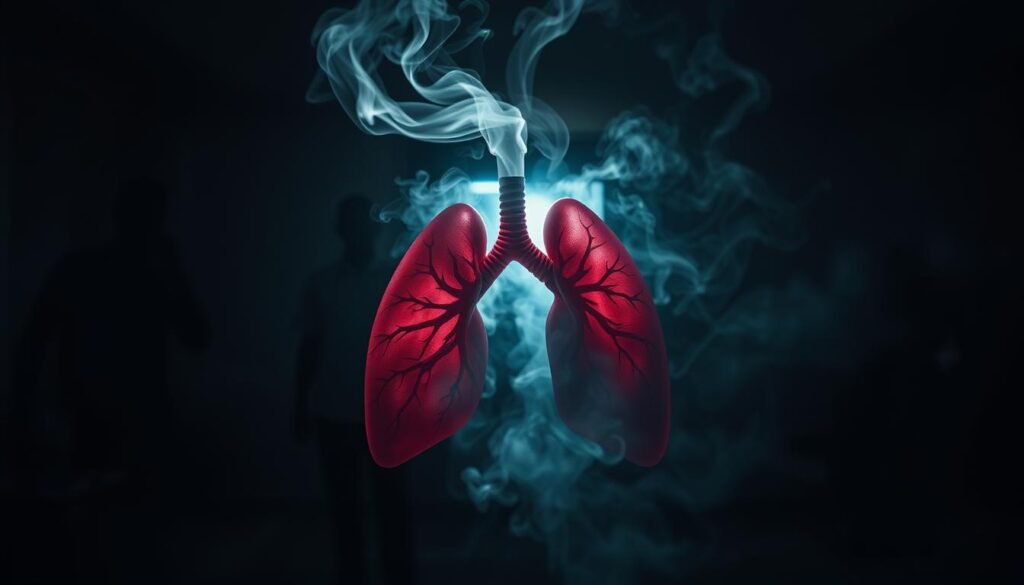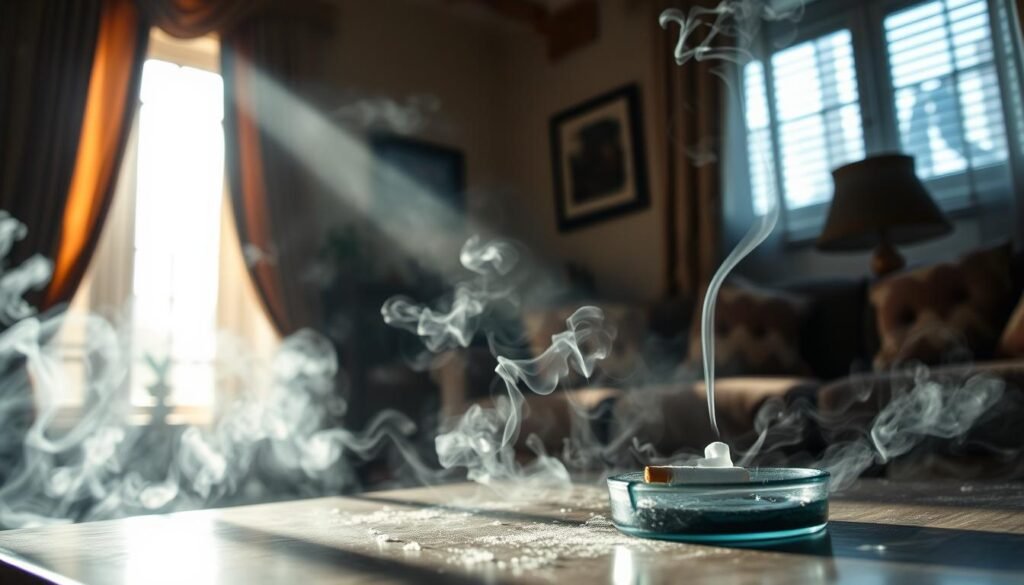It may shock you, but over 7,300 lung cancer deaths in the U.S. happen each year because of secondhand smoke. This statistic highlights the big risk of passive smoking, known as dangerous for over thirty years. Not just smokers, but non-smokers too, are in danger. Being around secondhand smoke ups the lung cancer risk by 20–30% for them.
Studies show an unnerving fact: 19,000 deaths a year come from secondhand tobacco smoke. It shows there’s no safe way to be around secondhand smoke without risk. It can cause immediate health issues like lung cancer, heart disease, and respiratory infections. The American Lung Association says laws to protect against secondhand smoke are key to public health. This points to the critical need for more support and awareness on this issue.
Key Takeaways
- Over 7,300 annual lung cancer deaths are caused by secondhand smoke among non-smokers.
- Involuntary smoking increases lung cancer risk by 20–30% for non-smokers.
- More than 19,000 deaths in the U.S. are linked to secondhand tobacco smoke each year.
- There is no safe level of exposure to secondhand smoke.
- Protective laws are crucial for public health against secondhand smoke exposure.
Understanding Secondhand Smoke
Passive smoking, or secondhand smoke, is when non-smokers breathe in smoke from smokers and burning tobacco. It’s a mix of over 7,000 chemicals, including 50 that cause cancer. It’s a big health risk for everyone around.
Environmental tobacco smoke (ETS) is dangerous. Even a little exposure can be bad for health. Non-smokers nearby can get lung cancer or heart disease from it.
Secondhand smoke can be found in homes, workplaces, and public areas. It’s important to have smoke-free places to lower health risks. Many places have laws to protect people from secondhand smoke.
Being around secondhand smoke is really risky, especially from birth to age 25. It can cause serious health problems. We need to know about these dangers and how to avoid them.
For more info on secondhand smoke, check out the National Cancer Institute.
Health Risks Associated with Secondhand Smoke
Secondhand smoke carries many health dangers for both adults and kids. For adults, it can boost lung cancer risks by 20 to 30%. This results in about 7,300 lung cancer deaths every year among non-smokers in the U.S. Besides lung cancer, it also increases the chance of coronary heart disease by 25 to 30%.
People around secondhand smoke are more likely to have strokes and chronic obstructive pulmonary disease (COPD). This smoke makes blood thicker, raising the risk of blood clots and heart attacks.
Children are especially at risk from secondhand smoke. They face more respiratory issues, infections, lower lung function, and problems like asthma and sudden unexpected death in infancy (SUDI). Even pets in homes with smokers can get sick from smoke chemicals.
Pregnant women exposed to secondhand smoke may have babies with lower birth weights. Governments and health groups highlight the importance of smoke-free spaces to keep us safe from secondhand smoke. You can learn more from trusted health sites.
The Statistics Behind Secondhand Smoke Exposure
Alarming data shows secondhand smoke exposure is a big problem. Every year, 30% of cancer deaths in the U.S. are due to cigarette smoke and secondhand smoke. This shows how dangerous being around smoke can be.
For adults who don’t smoke, secondhand smoke causes about 7,300 lung cancer deaths a year. If you live with someone who smokes, your lung cancer risk can go up by 20 to 30%. Heart disease deaths from secondhand smoke are about 34,000 annually. Women exposed to smoke can face issues with fertility and pregnancy too.
Being around smoke can increase your stroke risk by 20 to 30%. Since 2007, the National Cancer Institute’s Smoke-free Meetings Policy has been fighting these issues. The Tobacco Policy Viewer, started in 2018, helps track smoke-free laws in the U.S. over time.
Studies show that secondhand smoke means a higher lung cancer risk. Even 2-3 hours of exposure daily can greatly increase this risk. This underlines the need for education and action against tobacco’s harmful effects.
Secondhand smoke affects health broadly and negatively. Raising awareness can help us fight its dangers more effectively.
To learn more about secondhand smoke’s impact, check out this link.
Second Hand Cigarette Smoke and Lung Cancer Risk
Secondhand smoke poses a big threat to lung health. Many studies show a clear lung cancer correlation with exposure to it. It’s particularly risky for those exposed in their younger years.
The Link Between Secondhand Smoke and Lung Cancer
Research shows a clear tie between secondhand smoke and lung cancer. Being exposed from birth up to age 25 increases lung cancer risk. An adjusted odds ratio (AOR) of 1.30 proves it’s crucial to protect our lungs early. Secondhand smoke has over 50 carcinogens, which can cause severe health problems.
Increased Risk Factors for Non-Smokers
Secondhand smoke danger isn’t limited to smokers. Non-smokers, especially if exposed as children, face a 20-30% higher chance of getting lung cancer. This fact highlights the need to limit exposure from a young age. Learning about the health effects of smoking and secondhand smoke is key to prevention. Understanding the health implications helps us find ways to reduce risks.

Impact of Passive Smoking on Children
Children are highly affected by secondhand smoke. Their growing bodies and lungs can’t deal with the harmful substances in it. The Surgeon General has warned that being around tobacco smoke is dangerous for non-smokers, especially kids.
Health Consequences for Children
Secondhand smoke exposure can harm children by causing:
- Increased incidence of respiratory infections
- Worsening asthma symptoms
- Higher likelihood of developing chronic lung diseases
- Increased risk of ear infections and meningitis
Kids in homes with smokers face bigger health risks. They are more likely to get respiratory problems like coughs and colds.
Protective Measures for Children Against Secondhand Smoke
To keep children safe from passive smoking, think about:
- Creating smoke-free environments at home
- Pushing for no-smoking policies in public places, especially where kids go
- Telling parents and caregivers about the risks of secondhand smoke
Spreading the word helps make places safer for kids. Laws that prevent smoking in cars carrying children reduce their smoke exposure.
Environmental Tobacco Smoke and Lung Cancer
Environmental tobacco smoke, or ETS, is a serious health risk. It greatly increases the chance of lung cancer in non-smokers. Research has found that people living with smokers are about 1.3 times more likely to get lung cancer. This shows the alarming environmental tobacco smoke health risks from passive secondhand smoke exposure.
The cancer-causing compounds in ETS are similar to those found in cigarette smoke. These toxins are still dangerous to lung health, even in a diluted form. Recent studies have shown a strong link between secondhand smoke and an increased risk of lung cancer.

The numbers are shocking. The EPA says about 3,000 American non-smokers die yearly from lung cancer due to secondhand smoke. Of these, 800 deaths are from home exposure. About 2,200 are due to exposure at work or in public places.
This danger also affects children. Studies estimate between 150,000 and 300,000 kids under 18 months get pneumonia or bronchitis annually from secondhand smoke. This makes it clear how harmful ETS can be.
Furthermore, NIOSH views workplace ETS exposure as a potential cancer risk. This highlights the need to protect ourselves from environmental tobacco smoke. Even small amounts of exposure can badly affect our long-term health.
Workplace Exposure to Secondhand Smoke
Many workers still get exposed to secondhand smoke (SHS) at their jobs. This is a big health problem. Employers and groups that make rules need to pay careful attention. They must protect employees’ health according to the law.
Policies to Reduce Workplace Exposure
In the past, very few workers were protected by no smoking rules at work. Only 3% had such policies in the late 1980s. But now, more than 77% of people in the U.S. work under smoke-free laws. These rules help employees stay healthy by reducing the harm from SHS.
To make workplaces healthier, companies can help employees quit smoking. They can also create zones where smoking is not allowed. The Occupational Safety and Health Administration (OSHA) supports these efforts. They want employers to make sure workers aren’t exposed to SHS. This way, they help prevent serious health issues like lung cancer.
Yet, some jobs, like in construction and hospitality, still have a lot of SHS exposure. It’s important to keep improving the rules. These changes need to work for every type of job. That way, all workers can have a healthy place to work.
Indoor Air Quality and Its Relation to Secondhand Smoke
Indoor air quality drops significantly with secondhand smoke, or SHS, around. Smoking areas have more harmful particles, hurting our air. This pollution increases non-smokers’ risk of lung cancer. The American Lung Association pushes for smoke-free spaces to protect us from SHS.
Bad indoor air quality leads to health issues. Secondhand smoke has cancer-causing compounds that harm our lungs. In closed spaces, these dangers grow. Being around SHS increases a non-smoker’s lung cancer risk by 26%. This shows why smoke-free areas are so important.
To improve indoor air and fight SHS risks, follow these tips:
- Implement smoke-free policies in homes and public places.
- Regularly clean surfaces to remove thirdhand smoke residues.
- Encourage smokers to quit or seek cessation programs.
- Improve ventilation systems to enhance air circulation.
These actions help safeguard our health and clean the air. Whether at home or work, fighting secondhand smoke is key for everyone’s health. For more info on SHS, visit this resource.

Challenges in Reducing Tobacco Smoke Pollution
Reducing tobacco smoke pollution is a worldwide challenge. Public health advances face hurdles like economic interests and cultural smoking norms. Efforts to set strict smoking bans are slow, keeping vulnerable groups exposed to secondhand smoke and its dangers.
In the United States, only 62.5% of people are covered by comprehensive smokefree laws. This leaves many at risk. Some states have strong protections, but others are slow to enact necessary laws. Debates on the economic effects of tobacco regulation delay policy adoption, impacting efforts to cut secondhand smoke exposure.
Tobacco companies targeting young people adds to the problem. This strategy hinders progress toward the 2025 goal of reducing adult tobacco use by 30%. With nearly half of all smokers dying from tobacco-related diseases, reaching this goal is vital.
Changing how people view smoking is tough for public health campaigns. Many don’t fully understand the risks of tobacco smoke, including links to lung cancer and COPD. We need more advocacy to teach the public about these dangers and protect future generations.
| Statistics Related to Tobacco | Impact |
|---|---|
| Tobacco kills over 8 million people annually | Health crisis worldwide |
| 3.3 million deaths from lung-related conditions in 2017 | Need for effective legislation |
| 90% of lung cancer deaths linked to smoking | Critical health implications |
| 30% increased risk of lung cancer for nonsmokers with SHS exposure | SHS as a public health issue |
| 62.5% of U.S. population covered by 100% smokefree laws | Gaps in public protection |
Conclusion
Secondhand cigarette smoke’s dangers are serious and need quick attention to prevent lung cancer. People around secondhand smoke have a higher chance of getting lung cancer. Specifically, non-smokers exposed to it are much more likely to get diagnosed with lung cancer, showing how crucial public awareness is.
The longer someone is around secondhand smoke, the greater the risk, with a significant jump in lung cancer risk for those exposed for a few hours daily. This data proves we need to push for smoke-free areas to protect everyone’s health. Working together, experts, officials, and communities must create a plan to fight against secondhand smoke. Click here for more information.
It’s especially important to shield children and other vulnerable people from secondhand smoke. This means teaching the public and enforcing policies that prevent exposure. In the end, fighting secondhand smoke is a job for all of us, not just individuals.